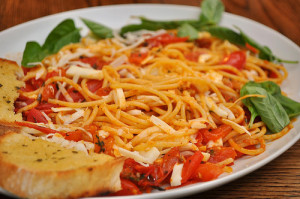|
It’s been a few years now since the low-carb/high-protein myth* was finally put to rest; however, there may be times when you need to get your protein on, and want to find some low-fat, high-protein choices. As a quick tip for finding these foods, know that when you’re looking at nutrition labels, the FDA considers foods that provide more than 20 percent of your RDA of protein per serving as “high protein.” That’s about 9 grams for an adult woman and 12 grams for an adult male. *You don’t lose more weight, it’s bad for athletes, and it can lead to health problems. |
 |
Seafood
Different types of fish provide different levels of nutrients, with some surprising results. Popular tilapia, served in more and more restaurants and groceries, has more Omega 6 fatty acid than Omega 3, which some researchers think can increase your chances for heart problems. Omega 3, found in abundance in salmon, can help reduce heart problems, but might raise the risk of prostate cancer.
For low-cal, high-protein seafood choices, try tuna, roughy, clams, monkfish, cuttlefish or crayfish. Salmon might be a higher-protein choice, but it’s also got many more calories than these other fish. Crayfish and other shellfish are higher in cholesterol than regular fish, but it’s not the quantity and type that doctors find so harmful (like the amount and type you get from a cheeseburger and fries). If you need to reduce your cholesterol intake, talk to your doctor about cholesterol from shellfish.
Cottage Cheese
Ugh. Cottage cheese. Not so fast! Yes, trying to choke down a plate full of this curdled cheese by itself can be a flavorless task, but served with other dishes, it can add a creamy counterpart to your breakfast turkey bacon or lunch tuna fish. Add some crushed nuts for some crunchy protein, or add berries or fruit for sweetness and more vitamins. The nuts and berries and fruit will add calories, but your protein source will be low in calories.
Eggs
Eggs are a great source of protein, and the warnings against cholesterol are now out the window (dietary cholesterol is not a killer). If you want to reduce calories in egg dishes, instead of using whole eggs, use egg whites to make your dishes. You can buy easy-pour cartons of egg whites, or egg beater substitutes that look and taste more like whole eggs. A half a cup of a commercial egg substitute contains no fat, has about 13 grams of protein (or 26% of your RDA for protein) and no cholesterol.
At the very least, think about making that three-egg omelet using only one yolk.
Chicken
Not all chicken is created equal. Don’t buy the cheapest cuts of the chicken or products that have “95 Percent Fat-Free!” splashed all over the package. That type of advertising takes into account the water contained in the chicken, allowing the calories from fat content to be much higher than 5 percent. Start with chicken breast meat and read the nutrition label. Look for the milligrams of protein (displayed as mg), percent calories from fat and daily percentages. While not “officially” high protein, turkey breast is close enough that you might want to check it out when you’re shopping for healthy proteins.
Who’s Your Edamame?
The next time you’re at a restaurant, ask if they have edamame (pronounced ed-uh-MA-may). You can also find it in bulk at shopper’s clubs or in your regular grocery store. Often served as a snackable appetizer, this high-protein food looks like snap peas and tastes similar. Edamame is immature soybeans, often served in the pod. As a snack, this green vegetable is boiled in saltwater, providing a tasty treat you can use in stir-fry or as something to munch on between or before meals. It’s cholesterol free, low-fat and a good source of iron.
Additional Resources
e-Tools Age: List of High Protein Low Calorie Foods
NYU Langone Medical Center: All About Shellfish
Harvard School of Public Health: Food Pyramids: What Should You Really Eat?
U.S. Department of Agriculture: Sample Menus for a 2000 Calorie Food Pattern
U.S. Department of Agriculture: Dietary Guidelines for Americans 2010
McKinley Health Center: Macro nutrients: the Importance of Carbohydrate, Protein, and Fat